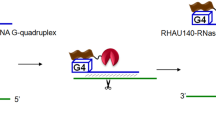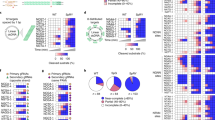Abstract
The artificial restriction DNA cutter (ARCUT) method to cut double-stranded DNA at designated sites has been developed. The strategy at the base of this approach, which does not rely on restriction enzymes, is comprised of two stages: (i) two strands of pseudo-complementary peptide nucleic acid (pcPNA) anneal with DNA to form 'hot spots' for scission, and (ii) the Ce(IV)/EDTA complex acts as catalytic molecular scissors. The scission fragments, obtained by hydrolyzing target phosphodiester linkages, can be connected with foreign DNA using DNA ligase. The location of the scission site and the site-specificity are almost freely tunable, and there is no limitation to the size of DNA substrate. This protocol, which does not include the synthesis of pcPNA strands, takes approximately 10 d to complete. The synthesis and purification of the pcPNA, which are covered by a related protocol by the same authors, takes an additional 7 d, but pcPNA can also be ordered from custom synthesis companies if necessary.
This is a preview of subscription content, access via your institution
Access options
Subscribe to this journal
Receive 12 print issues and online access
$259.00 per year
only $21.58 per issue
Buy this article
- Purchase on Springer Link
- Instant access to full article PDF
Prices may be subject to local taxes which are calculated during checkout





Similar content being viewed by others
References
Komiyama, M. & Sumaoka, J. Progress towards synthetic enzymes for phosphoester hydrolysis. Curr. Opin. Chem. Biol. 2, 751–757 (1998).
Hegg, E.L. & Burstyn, J.N. Toward the development of metal-based synthetic nucleases and peptidases: a rationale and progress report in applying the principles of coordination chemistry. Coord. Chem. Rev. 173, 133–165 (1998).
Blasko, A. & Bruice, T.C. Recent studies of nucleophilic, general-acid, and metal ion catalysis of phosphate diester hydrolysis. Acc. Chem. Res. 32, 475–484 (1999).
Williams, N.H., Takasaki, B., Wall, M. & Chin, J. Structure and nuclease activity of simple dinuclear metal complexes: quantitative dissection of the role of metal ions. Acc. Chem. Res. 32, 485–493 (1999).
Ott, R. & Krämer, R. DNA hydrolysis by inorganic catalysts. Appl. Microbiol. Biotechnol. 52, 761–767 (1999).
Bashkin, J.K. Hydrolysis of phosphates, esters and related substrates by models of biological catalysts. Curr. Opin. Chem. Biol. 3, 752–758 (1999).
Sreedhara, A. & Cowan, J.A. Catalytic hydrolysis of DNA by metal ions and complexes. J. Biol. Inorg. Chem. 6, 337–347 (2001).
Franklin, S.J. Lanthanide-mediated DNA hydrolysis. Curr. Opin. Chem. Biol. 5, 201–208 (2001).
Suh, J. Synthetic artificial peptidases and nucleases using macromolecular catalytic systems. Acc. Chem. Res. 36, 562–570 (2003).
Liu, C., Wang, M., Zhang, T. & Sun, H. DNA hydrolysis promoted by di- and multi-nuclear metal complexes. Coord. Chem. Rev. 248, 147–168 (2004).
Mancin, F., Scrimin, P., Tecilla, P. & Tonellato, U. Artificial metallonucleases. Chem. Commun. 2540–2548 (2005).
Mancin, F. & Tecilla, P. Zinc(II) complexes as hydrolytic catalysts of phosphate diester cleavage: from model substrates to nucleic acids. New J. Chem. 31, 800–817 (2007).
Strobel, S.A. & Dervan, P.B. Single-site enzymatic cleavage of yeast genomic DNA mediated by triple helix formation. Nature 350, 172–174 (1991).
Ferrin, L.J. & Cameriniotero, R.D. Selective cleavage of human DNA: RecA-assisted restriction endonuclease (RARE) cleavage. Science 254, 1494–1497 (1991).
Veselkov, A.G., Demidov, V.V., Frank-Kamenetskii, M.D. & Nielsen, P.E. PNA as a rare genome-cutter. Nature 379, 214 (1996).
Veselkov, A.G., Demidov, V.V., Nielsen, P.E. & Frank-Kamenetskii, M.D. A new class of genome rare cutters. Nucleic Acids Res. 24, 2483–2487 (1996).
Arimondo, P.B. et al. Recognition and cleavage of DNA by rebeccamycin- or benzopyridoquinoxaline conjugated of triple helix-forming oligonucleotides. Bioorg. Med. Chem. 8, 777–784 (2000).
Izvolsky, K.I., Demidov, V.V., Nielsen, P.E. & Frank-Kamenetskii, M.D. Sequence-specific protection of duplex DNA against restriction and methylation enzymes by pseudocomplementary PNAs. Biochemistry 39, 10908–10913 (2000).
Nomura, A. & Sugiura, Y. Sequence-selective and hydrolytic cleavage of DNA by zinc finger mutants. J. Am. Chem. Soc. 126, 15374–15375 (2004).
Eisenschmidt, K. et al. Developing a programmed restriction endonuclease for highly specific DNA cleavage. Nucleic Acids Res. 33, 7039–7047 (2005).
Nakatsukasa, T. et al. Site-specific DNA cleavage by artificial zinc finger-type nuclease with cerium-binding peptide. Biochem. Biophys. Res. Commun. 330, 247–252 (2005).
Miller, J.C. et al. An improved zinc-finger nuclease architecture for highly specific genome editing. Nat. Biotechnol. 25, 778–785 (2007).
Yamamoto, Y. & Komiyama, M. Site-selective scission of double-stranded DNA by combining peptide nucleic acids and Ce(IV)EDTA. Chem. Lett. 33, 920–921 (2004).
Yamamoto, Y., Uehara, A., Tomita, T. & Komiyama, M. Site-selective and hydrolytic two-strand scission of double-stranded DNA using Ce(IV)/EDTA and pseudo-complementary PNA. Nucleic Acids Res. 32, e153 (2004).
Yamamoto, Y. et al. Chemical-reaction-based site-selective DNA cutter for PCR-free gene manipulation. Chembiochem 7, 673–677 (2006).
Yamamoto, Y., Miura, K. & Komiyama, M. Site-specific scission of lambda phage genomic DNA by Ce(IV)/EDTA-based artificial restriction DNA cutter. Chem. Lett. 35, 594–595 (2006).
Sumaoka, J., Yamamoto, Y., Kitamura, Y. & Komiyama, M. Artificial restriction DNA cutters (ARCUT) for future biotechnology. Curr. Org. Chem. 11, 463–475 (2007).
Aiba, Y., Yamamoto, Y. & Komiyama, M. Activation of double-stranded DNA by one pcPNA strand for its site-selective scission with CeIV/EDTA. Chem. Lett. 36, 780–781 (2007).
Yamamoto, Y. et al. Chemical modification of Ce(IV)/EDTA-based artificial restriction DNA cutter for versatile manipulation of double-stranded DNA. Nucleic Acids Res. 35, e53 (2007).
Sumaoka, J., Azuma, Y. & Komiyama, M. Enzymatic manipulation of the fragments obtained by cerium (IV)-induced DNA scission: characterization of hydrolytic termini. Chem. Eur. J. 4, 205–209 (1998).
Kitamura, Y. et al. Recombination of the GFP gene to the BFP gene using a man-made site-selective DNA cutter. J. Biol. Inorg. Chem. 11, 13–16 (2006).
Nielsen, P.E., Egholm, M., Berg, R.H. & Buchardt, O. Sequence-selective recognition of DNA by strand displacement with a thymine-substituted polyamide. Science 254, 1497–1500 (1991).
Egholm, M. et al. PNA hybridizes to complementary oligonucleotides obeying the Watson–Crick hydrogen-bonding rules. Nature 365, 566–568 (1993).
Haaima, G., Hansen, H.F., Christensen, L., Dahl, O. & Nielsen, P.E. Increased DNA binding and sequence discrimination of PNA oligomers containing 2,6-diaminopurine. Nucleic Acids Res. 25, 4639–4643 (1997).
Lohse, J., Dahl, O. & Nielsen, P.E. Double duplex invasion by peptide nucleic acid: a general principle for sequence-specific targeting of double-stranded DNA. Proc. Natl. Acad. Sci. USA 96, 11804–11808 (1999).
Komiyama, M., Aiba, Y., Ishizuka, T. & Sumaoka, J. Solid-phase synthesis of pseudo-complementary peptide nucleic acids. Nat. Protoc. 3, 646–654 (2008).
Komiyama, M., Takeda, N. & Shigekawa, H. Hydrolysis of DNA and RNA by lanthanide ions: mechanistic studies leading to new applications. Chem. Commun. 1443–1451 (1999).
Kitamura, Y. & Komiyama, M. Preferential hydrolysis of gap and bulge sites in DNA by Ce(IV)/EDTA complex. Nucleic Acids Res. 30, e102 (2002).
Christensen, L. et al. Solid-phase synthesis of peptide nucleic acids. J. Peptide Sci. 1, 175–183 (1995).
Chen, W. et al. Site-selective DNA hydrolysis by combining Ce(IV)/EDTA with monophosphate-bearing oligonucleotides and enzymatic ligation of the scission fragments. J. Am. Chem. Soc. 126, 10285–10291 (2004).
Sambrook, J. & Russell, D.W. Molecular Cloning: A Laboratory Manual 3rd edn. (Cold Spring Harbor Laboratory Press, Cold Spring Harbor, New York, 2001).
Acknowledgements
This work was partially supported by a Grant-in-Aid for Specially Promoted Scientific Research from the Ministry of Education, Culture, Sports, Science, and Technology, Japan, and by Research Fellowships of the Japan Society for the Promotion of Science for Young Scientists (for Y.A.). Support by the Global COE Program for Chemistry Innovation is also acknowledged.
Author information
Authors and Affiliations
Corresponding author
Rights and permissions
About this article
Cite this article
Komiyama, M., Aiba, Y., Yamamoto, Y. et al. Artificial restriction DNA cutter for site-selective scission of double-stranded DNA with tunable scission site and specificity. Nat Protoc 3, 655–662 (2008). https://doi.org/10.1038/nprot.2008.7
Published:
Issue Date:
DOI: https://doi.org/10.1038/nprot.2008.7
This article is cited by
-
A Crisper Look at Genome Editing: RNA-guided Genome Modification
Molecular Therapy (2013)
-
Artificial site-selective DNA cutters to manipulate single-stranded DNA
Polymer Journal (2012)
-
DNA-catalyzed sequence-specific hydrolysis of DNA
Nature Chemical Biology (2009)
-
Solid-phase synthesis of pseudo-complementary peptide nucleic acids
Nature Protocols (2008)
Comments
By submitting a comment you agree to abide by our Terms and Community Guidelines. If you find something abusive or that does not comply with our terms or guidelines please flag it as inappropriate.



